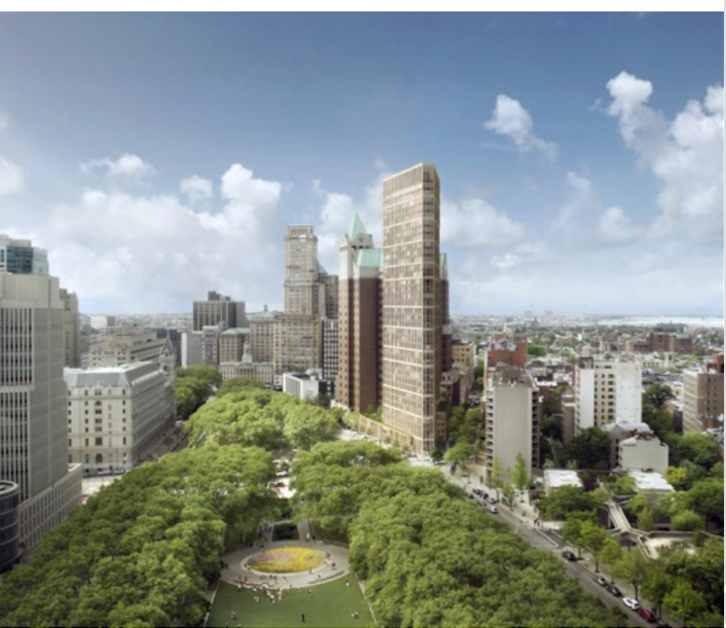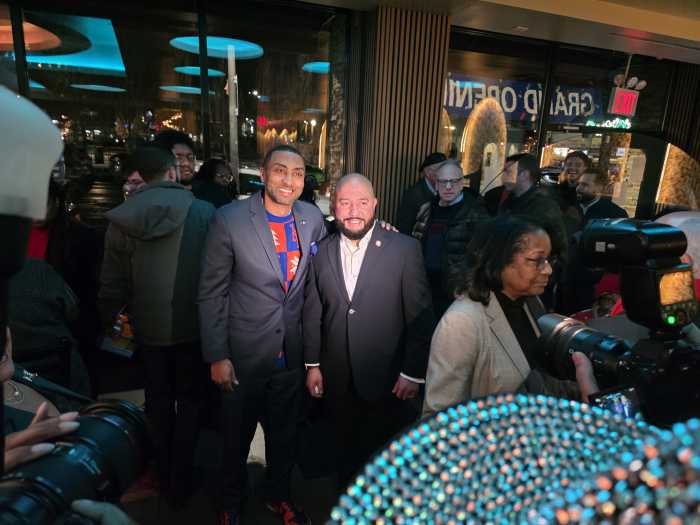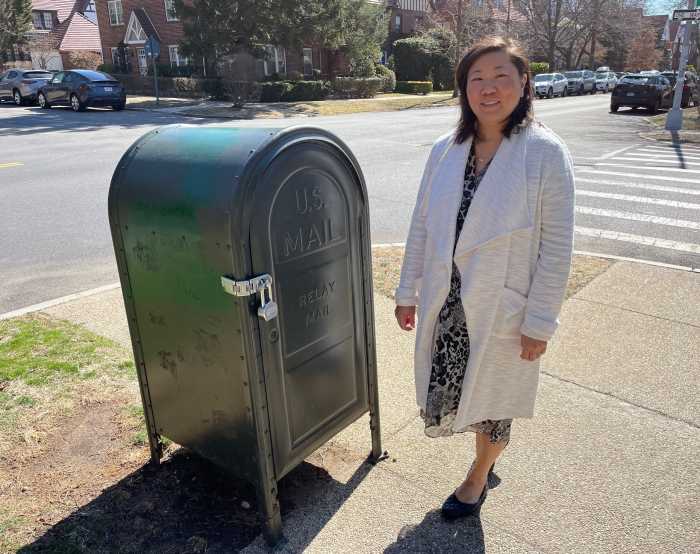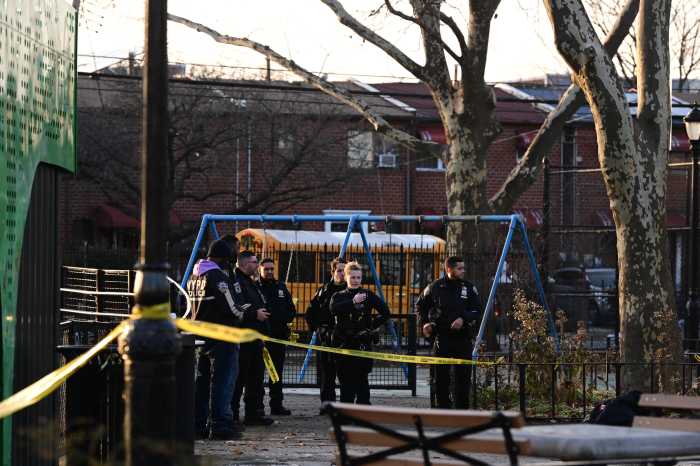Downtown Brooklyn City Councilman Stephen Levin went public on Facebook behind his thinking on why he decided to support the selling of the Brooklyn Public Library Cadman Plaza Branch, breaking down his thinking on the public benefits the sale brings.
Levin’s post comes amid some strong opposition to the libabry sale, but in which may of Levin’s colleagues in the City Council and among his constituents agree was a very tough decision to make.
Below is Levin’s thinking in its unedited entirety.

On December 16, the New York City Council voted to approve a modified version of the plan that has been put forward by the Brooklyn Public Library to sell the land and development rights at the Brooklyn Heights branch to Hudson Companies to be developed as condominiums, and replace the current library with a new library branch in the base of the new building. This has been one of the most, if not the most, controversial issues that I have encountered in my six years as your councilmember, and I went back and forth on whether or not to approve the proposal up until the final few days of the ULURP process.
Ultimately, I decided to support the proposal. I know many of you are very disappointed and unhappy with my decision, and I have heard from many of you regarding your disappointment. I have also heard from many of you who are happy with my decision and with the project as a whole. This was a very complex proposal and, in the end when weighing all of the benefits against the impacts, I honestly do believe that it was the right decision to approve the project. I would like to take this opportunity to tell you why.
It is important to note that all provisions represented as part of this project will be legally binding and enforced through the contract between NYC EDC and Hudson Companies until closing and in the deed of the property thereafter. In the instance where a portion of the project is dependent on the City of New York, we have a written confirmation from First Deputy Mayor Anthony Shorris that those commitments will be honored.
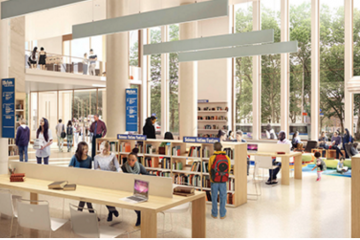
The Case Made by BPL
When BPL first approached me about this proposal in 2013, I was dubious. I thought it was a very drastic move to sell off land that is owned by the City of New York, the public, to a private developer in order to plug long-standing capital budget gaps. I remained skeptical for the duration of the process. However, there were several facts that made BPL’s case compelling.
1) The overall capital needs for BPL for the entire system are extremely high-$300 million. Even after Mayor de Blasio and the City Council added $100 million for BPL for 2015-2025, there is still $200 million outstanding with no sources of funding to meet those needs.
2) There are significant capital needs in the Brooklyn Heights branch itself, most urgently the HVAC, or air conditioning system, which has stopped working and needs to be replaced. Over the past few years, the Brooklyn Heights branch has had to cut hours during the summer because of the HVAC system and the cost of repairing it would be $3.5-5 million. I realize that this number sounds extravagant, but this would be a City capital project, which are usually around double or triple the cost of a private project. Also I met with the NYC Department of Design and Construction early in the process and they confirmed the cost and took me through what an HVAC replaced project would entail.
3) Selling the development rights over the Brooklyn Heights branch presents a unique opportunity for the BPL system in that, while it is currently zoned for a high-rise residential development, the current building is only two stories. That means that the development rights above the current building at 280 Cadman are worth many millions of dollars, money that could be used to meet some, though not all, of the $200 million in outstanding capital needs in other neighborhood branches throughout the system. If the current building were to stay as is, there is no realistic way to realize the value of those development rights. In addition, while I am no great fan of high-rise towers, the location of the Brooklyn Heights branch is in close vicinity of several other high-rise buildings along Court Street and Cadman Plaza West, so a new high rise would not be “out-of-context” along that stretch.
Library Space and Level of Service
It is important to take a moment to talk about the current library, which was built in 1961. It is a handsome building, having been designed by Francis Keally, one of the architects of the central branch. However, it is unlikely that the library would be considered the Landmarks Preservation Commission for a landmark status any time in the near future. The building itself can be divided into three parts, the Business and Career Branch, totaling 14,960 sq. ft., the Brooklyn Heights neighborhood branch, totaling 17,471 sq. ft., (with an additional 2,966 sq. ft. of at-grade mechanicals) and the two cellar floors, totaling 23,749 sq. ft., which were originally constructed as a fallout shelter, and which are currently used for storage of some circulating, but mostly non-circulating, reference books and other uses such as books that are donated but not yet sold at the BPL book sale. The two cellar floors are not publicly accessible, and it is reasonable to believe it would cost millions (perhaps many millions) of dollars to make this space suitable for any meaningful public access. Therefore, while the entire building is, according to the City Planning Commission, 59,146 sq. ft., only 32,431 sq. ft. are above ground as the Brooklyn Heights branch and the Business and Career Library branch, with 27,222 sq. ft. accessible to the public (the rest being utility space and staff office space), and it would be very difficult to envision a scenario in which all 59,146 sq. ft. could be made to be publicly accessible. Based on this set of facts, I made the decision that a sq. ft.-for-sq. ft. replacement of the publicly accessible space would require a new library to be roughly 32,000 sq. ft., because that number more accurately what the public experiences when they use the library.
When BPL first presented the plan, they proposed a 21, 000 sq. ft. neighborhood branch, which would in fact be an increase from the current 17,471 sq. ft. neighborhood branch. They also proposed moving the Business and Career Library branch to the Central branch, leaving the overall Brooklyn Heights facility with a decrease from 32,431 sq. ft. to 21,000 sq. ft. Like many of you, I found this proposal unacceptable, and I insisted that there be no net loss of publicly accessible library space in the neighborhood.
During the course of discussions with BPL, Hudson Companies, and the de Blasio administration, they proposed to increase the size of the new Brooklyn Heights branch to 26,500 sq. ft. with roughly 24,000 sq. ft. of it publicly accessible, which represented a decrease of 5,931 total sq. ft. and about 3,222 publicly accessible sq. ft. for the overall facility. I responded to this proposal by saying it was not good enough. At this point, however, the Department of City Planning advised us that, due to technical zoning regulations, the new library could not be greater than 26,500 sq. ft. without being “out of scope” and thus requiring another new rezoning application. I remained adamant that there not be a net decrease in publicly accessible space, but we hit a roadblock in that discussion.
BPL then proposed a solution to this issue, which was to find roughly 5,000 sq. ft. of rental space in the DUMBO/Vinegar Hill/Farragut communities for a new neighborhood branch. There is in fact precedent for both rental space and roughly that size of a branch in the BPL system, and this would be the first new branch in the BPL system since 1983 with the opening of the Cortelyou branch. In addition, at 5,000 sq. ft., the new branch, when combined with the 26,500 sq. ft. already committed to for the expanded Brooklyn Heights branch, would bring the total sq. ft. in the community to 31,500 sq. ft., with about 28,000 publicly accessible. This would mean a slight decrease in overall useable sq. ft. (32,431-31,500=969 sq. ft. decrease) but a slight increase of publicly accessible sq. ft. (28,000-27,222=778 sq. ft. increase).
In addition, I was very concerned about the level of service that would be offered in the new branch. As many of you know, over the past few years, the level of service at the Brooklyn Heights branch has been significantly wanting. In particular, the library was closed for much of the summer due to the broken HVAC system, which led to a thermal heat index temperature in the building that was so high it violated union rules for employees. In addition, the library was not open 7 days per week during any season and the level of programming was lower than many other neighborhood branches.
Therefore, I gained a commitment from BPL that the level of programming at the new Brooklyn Heights branch would be equal to or greater than any other neighborhood branch in the system. Also, BPL committed to the condition that the Brooklyn Heights branch would be open 7 days per week so long as the Kings Highway branch, which serves as the main branch for South Brooklyn and is therefore open 7 days per week, maintains those hours.
Fair Market Value
Another major point of concern for me was the value of the project, and whether the public is getting a fair price at $52 million for the development rights at 280 Cadman. This turned out to be a more complicated question than I anticipated, and I asked about a half dozen very knowledgeable experts whether the public was in fact getting a reasonable deal on this property. Unfortunately, a definitive answer remained elusive. On the one hand, there was a competitive process in which Hudson participated and bid against other potential developers. Also, an NYC EDC sponsored appraisal determined that the value of the development fights was found to be approx.. $36.1 million, significantly less than the $52 million sale price. On the other hand, the market in the neighborhood seems to be attracting much higher prices-for example the TD Bank property at Court and Montague is on the market for $200 million.
One aspect that I had not previously accounted for is that the price of $52 million does in fact account for the cost that the developer would have to bear in order to build the required affordable housing without any city subsidy which, between the land price and the cost of construction, would cost roughly $32 million, not to mention the cost of the “core and shell” of the new library space, the cost of the interim library, and “soft costs” of the City during the process of the sale.
Since it was not becoming apparent what the free fair market value of the property would be, and since it is impossible to predict exactly what Hudson Companies’ profit on this project will be in 4-5 years, I made the decision to follow the recommendation made by Borough President Adams and pursue some type of “profit recapture” or “participation,” through which BPL or the City can ensure that, if the Hudson Companies makes a significant profit, BPL is able to recapture a percentage of that profit. This model is used at Brooklyn Bridge Park and has been successful.
Eventually we were able to reach a consensus of what that “participation” level should be, based on an Internal Rate of Return (IRR), which, according to the experts I spoke to, is reasonable for a developer building a condo project in downtown Brooklyn at 18-22%. Therefore, we agreed that if Hudson makes a profit over 19%, BPL would recapture 25% of that profit. That means that if, as many are concerned about, Hudson makes an enormous profit (which would mean an IRR of much higher than 19% and that perhaps the $52 million sales price was undervalued), the public and BPL have the protection of recapturing 25% of that profit over 19% IRR. Since this project is condominiums, this “recapture” will only happen one time, which is when Hudson sells the condominiums around 2020-2021, but there is the potential of BPL receiving millions of dollars more at that time.
We did include a caveat to this, in that the first $1.5 million in recaptured funds would be used to make the AMI’s on the affordable units lower, from a maximum of 165% of AMI to 125% of AMI.
As with all of the provisions of this project, this agreement will be recorded as part of the deed for the property and will be legally enforceable on any future developer.
Education
Another aspect of this proposal that was very important to me was ensuring that there were some public education resources as part of the project. We all know the significant public education needs of Brooklyn Heights and the surrounding neighborhoods. PS 8 is direly overcrowded and we are facing the need of an overall lack of school space in Downtown Brooklyn to accompany the staggering amount of new residential development occurring as a result of the 2004 Downtown Brooklyn rezoning.
My initial feeling was there needed to be additional school seats, either elementary or middle, as part of this development, just like there was at Dock Street where there will be 330 seat middle school opening next fall. My thinking was that a school could be sited on floors two and three of the building, above the new library. I contacted the School Construction Authority (SCA) about the site and the feedback from them was that siting a school in this building would be virtually impossible given the configuration of the building and the requirements that siting school seats would entail, including adding 5,000-10,000 sq. ft. of entirely contained school lobby space on the ground floor (which was already fully planned with library and residential lobby), a self-contained elevator bank exclusively for the school, and enough space for a school on what are 16,000 sq. ft. floor plates. After speaking with SCA, I realized a new school there would not be possible.
However, I spoke with local education leaders about what other educational needs are in the community and one idea specifically appealed to me: the development of a STEM lab for students K-12. The NYC Dept. of Ed. does not currently have any totally open facilities like this, but we all know that an innovative STEM curriculum with a brand new STEM lab could be amazing for our children. There are so many interesting k-12 STEM learning environment models from Minnesota to Altanta to Palo Alto that we can learn from: why not search out what is working best and implement it here?
Therefore, I worked with the de Blasio administration, DOE, SCA, and Hudson Companies on an agreement where DOE will lease 9,000 sq, ft. from Hudson in the first cellar, with the option to purchase the space after years, where there will be a fully built out STEM lab. We look forward to working with everyone in the community, particularly those with an interest in STEM education, on developing this potentially transformative space.
Affordable Housing
The original proposal contained 114 units of affordable housing, to be located off-site in Clinton Hill, ranging in affordability level from 60% AMI (Area Median Income) to 165% AMI (AMI in NYC is $86,300 for a family of 4), with 23 at 60% AMI, 38 at 80% AMI, 29 at 100% AMI, and 24 at 165% AMI. Under this scenario, the 60-80% AMI units are actually required under the Inclusionary Housing Program, while the 100-165% AMI are not required. I heard from many of you that this issue of of-site affordable housing is disturbing and should not be allowed as part of this project. Also, many of you said that the AMI level were too high to respond to the real affordable housing crisis in our communities.
I was very concerned about these issues as well. We found the off-site issue difficult to resolve. First, under the current Inclusionary Housing Program, off-site affordable housing is allowed. This may change with the Inclusionary Housing reforms being contemplated right now, but the current law allows it. Also, if we were to require the affordable housing to be built on-site, it would inevitably drive down the purchase price of the of the development rights at 280 Cadman, which would mean significantly less money for the BPL system as a result of this sale. In addition, I heard from leaders in Clinton Hill that they were in fact very happy to have 114 units of affordable housing in that community, which desperately needs it. Therefore, I decided that, while I am not enthusiastic about the off-site affordable housing, I would allow for that portion to go through based on the specifics of this particular project.
I did have a significant concern about the AMIs, because I strongly believe that units at 165% AMI should not be considered “affordable” since they are for families making $142,395 per year, which I believe is close to, if not at, market rate. Therefore, I worked with Hudson to develop a new affordability framework that I believe more effectively addresses the needs of working families in our communities: 23 units at 60% AMI, 60 units at 80% AMI, and 31 units at $125 AMI.
Conclusion
After over two years of discussions, debates, hearings and testimony, I believe that this project has had a thorough vetting and that the public has been able to obtain a good understanding of all of the issues surrounding this proposal. And while the final agreed-upon project is not ideal, I believe that it is a significant improvement both over the status quo and the originally proposed project.
During the final couple of weeks of that process, after hearing from hundreds of community residents both for and against this project, I had the opportunity to speak with two librarians that work at the Brooklyn Heights library, Uldis Skrodelis and Rachel Teimann about the project. They both expressed their support for the project because ultimately they believe strongly that new libraries in Brooklyn Heights and in DUMBO, complete with both books and 21st century technology, will be the best way ensure that future generations of children and adults have access to the full educational potential of our libraries. I took their advice to heart.
It will be several years before the public will see the benefits of this project-the new library in Brooklyn Heights, the new library in DUMBO/Vinegar Hill/Farragut, the new STEM lab, the new affordable housing, potentially additional revenue through the profit recapture. However, I believe that when these new benefits are realized, the public will see that its interests were protected through its advocacy and the land use process that we rely on in our city.
Thank you all for your time, your passion and your advocacy. Happy holidays.


